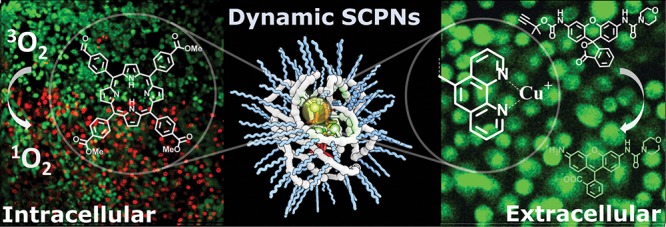- Record: found
- Abstract: found
- Article: not found
Catalytically Active Single-Chain Polymeric Nanoparticles: Exploring Their Functions in Complex Biological Media

Read this article at
Abstract

Dynamic single-chain polymeric nanoparticles (SCPNs) are intriguing, bioinspired architectures that result from the collapse or folding of an individual polymer chain into a nanometer-sized particle. Here we present a detailed biophysical study on the behavior of dynamic SCPNs in living cells and an evaluation of their catalytic functionality in such a complex medium. We first developed a number of delivery strategies that allowed the selective localization of SCPNs in different cellular compartments. Live/dead tests showed that the SCPNs were not toxic to cells while spectral imaging revealed that SCPNs provide a structural shielding and reduced the influence from the outer biological media. The ability of SCPNs to act as catalysts in biological media was first assessed by investigating their potential for reactive oxygen species generation. With porphyrins covalently attached to the SCPNs, singlet oxygen was generated upon irradiation with light, inducing spatially controlled cell death. In addition, Cu(I)- and Pd(II)-based SCPNs were prepared and these catalysts were screened in vitro and studied in cellular environments for the carbamate cleavage reaction of rhodamine-based substrates. This is a model reaction for the uncaging of bioactive compounds such as cytotoxic drugs for catalysis-based cancer therapy. We observed that the rate of the deprotection depends on both the organometallic catalysts and the nature of the protective group. The rate reduces from in vitro to the biological environment, indicating a strong influence of biomolecules on catalyst performance. The Cu(I)-based SCPNs in combination with the dimethylpropargyloxycarbonyl protective group showed the best performances both in vitro and in biological environment, making this group promising in biomedical applications.
Related collections
Most cited references2
- Record: found
- Abstract: not found
- Article: not found
Intramolecular Cross-Linking Methodologies for the Synthesis of Polymer Nanoparticles.
- Record: found
- Abstract: not found
- Article: not found
